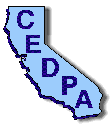
 |
California Educational Data Processing Association |
The DataBus - Vol. 37, No. 3
|
Editor's note: The last issue of The DataBus featured a lead article about the Computerworld Smithsonian Award nomination received by the Desert Sands Unified School District for their accomplishments in technology. This month presents an expanded look into the district and the events surrounding their nomination.
On May 2nd we would like to conclude the week with "Future of K-12 Education and Technology" forum by the CEOs of the companies and possibly Mr. Pete Wilson, California Governor. The companies included in our network and invited to participate are Microsoft, Kodak, Cisco, 3Com, Allied Telesyn, View Tech, Meridian, New Technologies, Pentamation, Microwave Bypass, Applied Computer Systems, and Ansi. The Computerworld Smithsonian Awards program will give recognition to the Board of Education on that day.
In June 1993, after thoroughly researching what networking strategies were available, we decided to use microwave technology. Through microwave we can transfer data at 10 million bits per second for the computer network, full motion video/audio for video conferencing, and voice for telephone. Microwave technology proved to be more reliable, more cost-effective, faster and easier to maintain than leased telephone lines. Another advantage was that after five years, the microwave equipment would be paid for without the recurring fees experienced with lease lines.
With the cooperation of Riverside County, the first six microwave links were installed in Indio in February 1994. These links, constructed by Microwave Bypass Inc., of Braintree, Mass., connected the easternmost and westernmost schools, and connected the resulting network to the central microwave repeating site at Riverside County's Larson Justice Center in downtown Indio. By April 1995, 19 links were in place and all district sites were on line, with e-mail and the new student management software in operation.
A six-city metropolitan microwave network allows every classroom and office in the Desert Sands Unified School District access to a variety of high-technology applications at high data transfer speeds. Students and staff have access to the Internet at speeds of 10 million bits per second, which allow them more time to work on projects or teach classes rather than wait for a slow network connection delivering data to their computer. Most analog telephone lines take five to 30 minutes to download one page of information, whereas our network takes only seconds. Students and staff also have access to shared technologies such as our fully loaded Kodak imaging center, a Kodak high speed printer capable of printing 92 pages a minute, Meridian CD towers, students and financial programs and important district information on our internally networked servers.
Because of the high data transfer speeds of microwave equipment, we were able to implement such highly sophisticated and network-intensive software applications as the following:
All of these services, together with the resources of a fully functional Kodak digital imaging center at La Quinta High School, can be accessed from any networked computer at any district site.
While the network installation was in progress, staff training began. Each school sent four teachers to a computer class where they were trained on how to build a multimedia computer cart and how to incorporate multimedia into their curriculum. The teachers built their computers from pieces: they installed the motherboard and drive cards, loaded multimedia software, connected a Laserdisc player, connected an LCD panel for an overhead projector and learned how to troubleshoot IBM-compatible computers. Once they completed their multimedia computer carts they were trained on how to prepare multimedia presentations, including multimedia lesson design and incorporation of the design into their lesson plans utilizing CD-ROMs and Laserdiscs. After the training, teachers took their multimedia carts to their schools and began sharing their knowledge with their peers. On-going personnel training continues for all district employees. The original goals that were established at the onset of the technology plan have been met. The entire district is networked and every teacher and employee has Internet access and standard software. Our microwave metropolitan area network is fully operational. Schools and administration offices are all on-line. Every teacher has at least one computer in his classroom, connected to the network. Approximately 20,000 people are receiving benefits of the microwave network. Students, teachers, classified personnel, counselors, administrators and libraries have access to the Internet, e-mail, and Microsoft software. Students and teachers are taking advantage of the communication possibilities and working on many different projects. The computers are becoming one of the best tools for improving the teaching and learning in the classroom.
The future plans are the most important consequences of the accomplishment of this project. Because of the caliber of the network we have tremendous opportunity to become involved in truly incredible projects. For example: